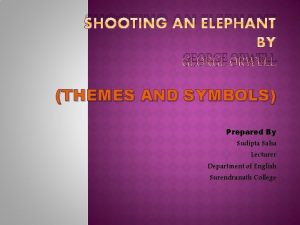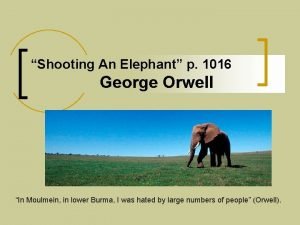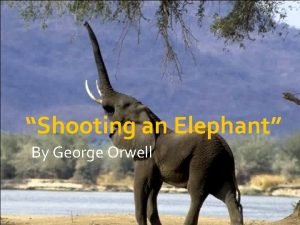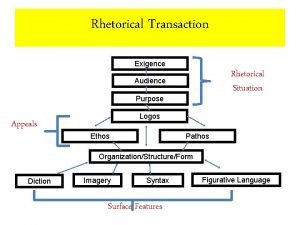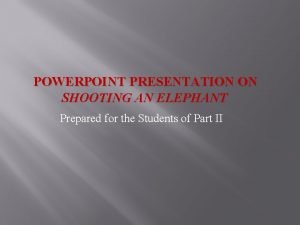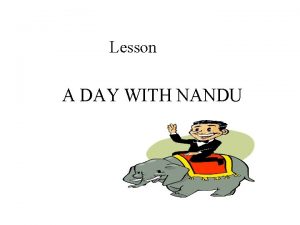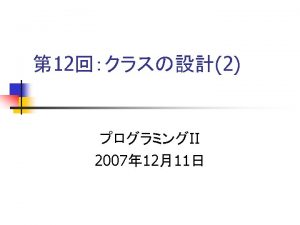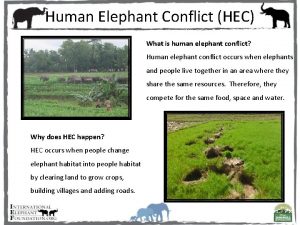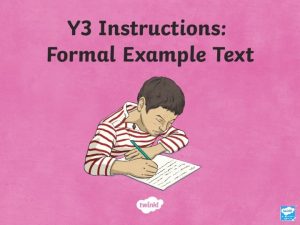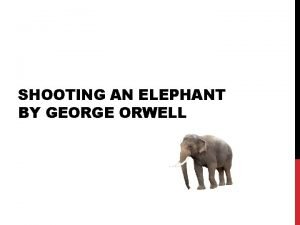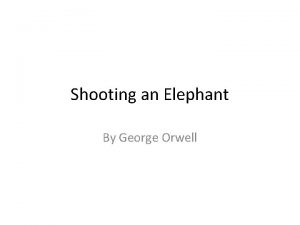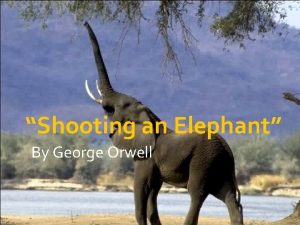POWERPOINT PRESENTATION ON SHOOTING AN ELEPHANT Prepared for

















- Slides: 17

POWERPOINT PRESENTATION ON SHOOTING AN ELEPHANT Prepared for the Students of Part II

Shooting an Elephant Author : George Orwell Genre : Essay Published in : New Writing Year of Publication: 1936

List of Characters � � � George Orwell: Holds the central role being a police officer who despises the British imperial project in Burma in , sides with the Burmese, yet attempts to prove his authority to the Burmese. The sub-inspector: A Burmese policeman who answers to Orwell. He’s waiting for Orwell at the bazaar where the elephant has been rampaging. The Dead Man: A body trampled into mud by the rampaging elephant.

Themes Imperialism � Colonial Discourse Imperialism � Representation Colonial Discourses � Identity Politics Representation � White Man’s Burden Identity Politics � Mimicry � • • • White Man’s Burden Mimicry

Plot � � � The narrative of the essay unpacks Orwell’s psychological conflict while performing his duty as a police officer for the British Raj in colonial Burma In his role of representing the British Empire he upholds the stance of ‘ambivalence’ His ambivalent attitude is expressed in his confession of hatred for the colonial mission practicing entrenched hostility towards the colonised ‘other’ i. e. the Burmese people.

Plot � � On the other hand the combination of his sympathetic gesture and resentment towards the Burmese people who never used to leave a scope to harass him further emphasizes his psychological dilemma. Orwell himself becomes a subject being a part of the colonial mission justifying the ‘self-other’ binary.

Plot � � In order to keep the narratives of colonial discourse undisturbed, he keeps on identifying the Burmese populace as images of ‘yellow faces’, mysterious beings, inborn liars, full of satanic litany and animalistic intent. The politics of the accepted superiority of the Empire and the acknowledged inferiority of the Burmese people is further emphasized through the expression of their eager eyes ready to witness theatre of killing of the elephant by the colonial master , represented by Orwell himself.

Plot � � � Orwell himself becomes the subject carrying the white man’s burden His conflicted emotion reaches its height when he is to control the elephant undergoing a bout of “must” breaks its chain His moral consideration holds him back from killing the elephant while his elevated status being a part of the imperialistic mission demands his coerssive performance to fulfil the demanding eyes of the ‘natives’

Plot � � The dramatic act of killing the elephant by his repetitive application of bullets in disparate parts of the body earns him acclaim from the natives The narrative ends with the question of aptness of the act of killing performed by Orwell, the colonial police officer who was to measure the value of life of the Burmese coolie whom the elephant trampled, with the value of the animal that he himself killed

The Violent Act of the Rampaging Elephant

‘…peacefully eating, the elephant looked no more dangerous than a cow’

The Performance of Imperial Mission

Justice is Done

The Theatre of Killing

Use of Symbols and Motifs � � The Policeman : As a police officer, Orwell’s presence holds symbolic power in Burmese society. The tortured body: The image of the naked, scarred buttocks of a prisoner represents the power structure dominant in the Geographical domain referred to. The Elephant : The rampaging elephant is a symbol of Burmese society , uncontrollable and violent , making itself known by jeers and humiliation. The Crowd: As a motif the crowd reflects the eyes of Burmese society, closely observing their colonizers.

Allegory � The Act of Shooting the Elephant: The shooting of the elephant functions as an allegory for the British colonial project in Burma. Orwell psychological dilemma before killing the elephant represents the guilt of attempting to command over an entire culture and society.

Thank You
 Symbols
Symbols Shooting an elephant george orwell summary
Shooting an elephant george orwell summary Shooting an elephant vocabulary
Shooting an elephant vocabulary Exigence in literature
Exigence in literature Shooting an elephant setting
Shooting an elephant setting George orwell ppt
George orwell ppt Worksheet on a day with nandu
Worksheet on a day with nandu What is a key stone species
What is a key stone species Rotary powerpoint template
Rotary powerpoint template Apa format running head
Apa format running head Pecha kucha image
Pecha kucha image Notice present continuous
Notice present continuous Acknowledgement for ppt
Acknowledgement for ppt Site initiation visit powerpoint presentation
Site initiation visit powerpoint presentation Ppt hitler
Ppt hitler Powerpoint disclaimer examples
Powerpoint disclaimer examples Bim presentation ppt
Bim presentation ppt Advantages and disadvantages of ms powerpoint
Advantages and disadvantages of ms powerpoint
